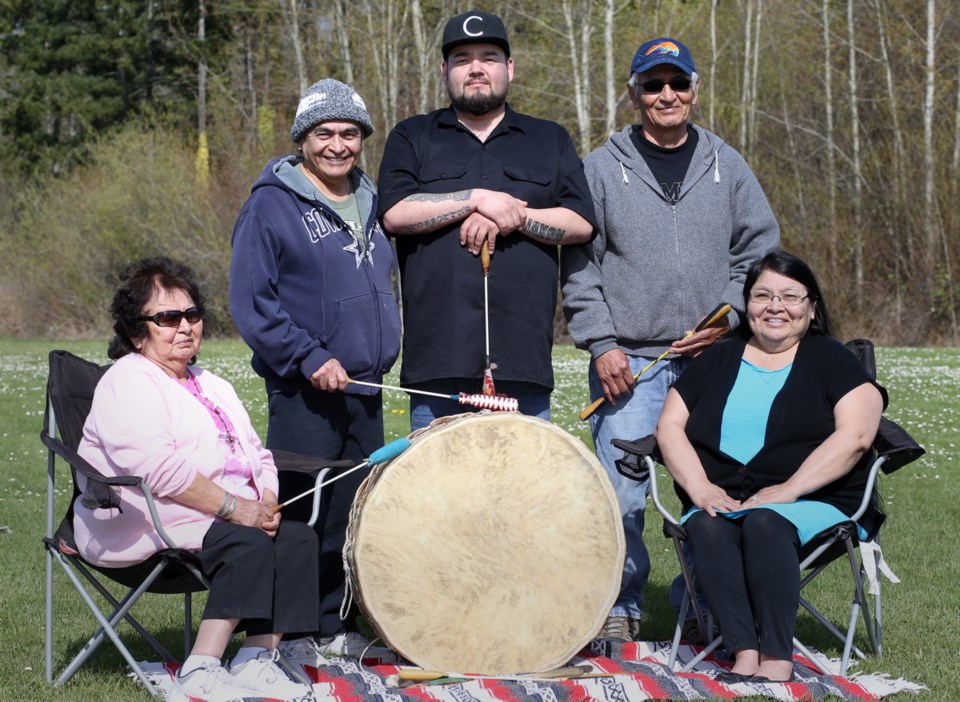John Sampson was known to many as the friendly artist with long braids who with his wife Joan had a regular spot at the bottom of the Inner Harbour causeway stairs, where they sold his hand-painted drums, moccasins and rattles and her beadwork.
“We met so many people from all over the world there,” Joan said at their home on the Tsartlip reserve in Brentwood Bay. Most days, they’d have the car packed and be on the road before 7 a.m. In recent months, John’s health worsened but he still tried to make it there — oxygen tank and all. When the Sampsons pulled up, their fellow artisans hopped to it.
“As soon as they’d see John, they came running and dragged our suitcases down,” Joan said.
“We made a lot of friends there. People would ask the history of each design. They wanted to learn,” she said. “He would tell the story behind every drum.”
John Sampson died March 29 after a lengthy illness related to asbestos exposure at a Victoria shipyard where he worked in his younger years. He was 68 years old and is remembered by his wife, Joan, his four children, three stepchildren, grandchildren, siblings and many relatives.
Those who got to know John would discover he was not only a talented Coast Salish artist, but also the proud descendant of Chief Joseph of the Nez Perce. The chief led a famous resistance against Americans who forced aboriginals off their traditional lands and onto reservations.
The bravery and skill of his people were praised even by their enemies. Despite eventual defeat, Chief Joseph became an outspoken advocate for aboriginal rights, meeting with three U.S. presidents.
Sampson’s Tsartlip father met his Nez Perce mother when he travelled to Washington for a baseball tournament. They came back to live in Tsartlip and raised 12 children in a small shack with no running water, electricity, television or phone.
In the early 1990s, John, the fifth born, and his siblings began to dig into their mother’s cultural heritage, including the practice of powwows.
They formed the Yellow Wolf drum group and decided to hold a powwow at Tsartlip Park.
“People were curious because that’s not part of Coast Salish culture. But we spent our lives learning our dad’s cultural ways and wanted to honour our mother,” said Angel Sampson, John’s younger sister. The intertribal powwow became a hit, attracting people from the Island and other countries. This year’s event, on B.C. Day long weekend, will mark the 21st year.
“It was a different type of gathering, but also something that brought focus to the youth that helped them follow a good path. There are no drugs or alcohol permitted on the grounds.”
John learned to drum, sing and dance in the powwow style. He also became a whistle carrier — a traditional role bestowed from his Native American relatives. His drum-making flourished under the mentorship of a Tsawout relative named Teestah, starting from untreated hides to the painting of Coast Salish designs on the finished product.
“[John] kept saying: ‘My mom always wanted me to be a powwow singer and a dancer.’ It became a passion for him to learn,” recalled his brother Murray (Muzz) Sampson. “He always maintained the right frame of mind, especially in what we do culturally. He was never angry and he was very patient with people.”
The Sampson family gathered in Joan and John’s home for weeks after his death. Some sat quietly underneath John’s many painted drums on the walls. Others shared memories, tears and moments of laughter in the kitchen or at the dining room table — where lit candles stood vigil.
John’s siblings reminisced about his early years as an accomplished sportsman who loved the outdoors, fishing, hunting and learning traditional skills.
“All my brothers played soccer well, and even our dad,” John’s younger sister Christine Paul said, as someone pulled out a family photo of Francis (Doc) Sampson and his soccer team from the 1940s.
“He was also a long-distance runner. He was tireless,” Murray Sampson piped in. He said John was proud when his son, John Jr., took part in the 535-kilometre Heliset Hale Marathon last year — which raised suicide awareness from Port Hardy to Victoria. He drove to visit him at rest stops along the way.
John was proud of all his children, Joan said.
She and John first met in residential school on what was then called Kuper Island. It is now known as Penelakut Island. That’s where he was a drummer in the school marching band, for the sole purpose of getting off the Island for performances and away from a school that became notorious for its poor treatment of First Nations students.
Joan said she remembered seeing John always surrounded by female students and didn’t get to know him until they were introduced years later by friends — after they’d both had children and were separated from their spouses.
“I was teasing him later and said: ‘You were always surrounded by girls,’” Joan recalled. “He said: ‘Those were my cousins!’ ”
The pair fell in love and spent nearly 36 years together, getting married in a private ceremony with two friends as witnesses. Over the years, they travelled to attend craft fairs, powwows and elder gatherings.
“He loved his drums, to work on his drums. He always called them the heart of the aboriginal people,” Joan said.
John helped many people in the family and the community at large, said his eldest brother Tom Sampson.
“He was instrumental in keeping our mother’s culture alive. He was a teacher who never turned someone away. He inspired us all,” he said.
